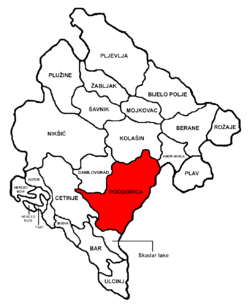Podgorica Capital City
| Podgorica Capital City Glavni grad Podgorica / Главни град Подгорица | |
|---|---|
| Municipality | |
 | |
| Coordinates: 42°28′12″N 19°16′48″E / 42.47000°N 19.28000°ECoordinates: 42°28′12″N 19°16′48″E / 42.47000°N 19.28000°E | |
| Country |
|
| Seat | Podgorica |
| Number of settlements | 143 (136 rural, 7 urban) |
| Area | |
| • Total | 1,441 km2 (556 sq mi) |
| Population | |
| • Total | 301,859 |
| • Density | 210/km2 (540/sq mi) |
Podgorica Capital City (Montenegrin: Glavni grad Podgorica / Главни град Подгорица) is one of the territorial subdivisions of Montenegro. The seat of municipality is the city of Podgorica.
Administration
As with other Montenegrin municipalities, the city and the municipality of Podgorica are governed by the same mayor and city assembly, forming one political body. See politics of Podgorica.
Subdivisions
Municipality of Podgorica is the only Montenegrin municipality to have urban municipalities (Gradske Opštine) - Tuzi and Golubovci. Those are semi-independent municipalities, with limited self-governing powers. The entire municipality of Podgorica is further divided into 57 local communities (mjesne zajednice, мјесне заједнице), bodies in which the citizens participate in decisions on matters of relevance to the local community.
Geography
The municipality of Podgorica is located in central eastern part of Montenegro, covering an area of 1,441 km², thus being the second largest Montenegrin municipality, after Nikšić. It occupies the area north of Skadar Lake, including the entire Zeta Plain, and stretches north into the sparsely populated Dinaric Alps. Thus, the municipality occupies geographically very diverse area, ranging from the fertile lowlands in the south, to the rugged mountain ranges in the north.
Demographics
Podgorica municipality can be viewed as the metropolitan area of the city of Podgorica. Population of the municipality was 185.937 in 2011.
Population by settlement
| Settlement | Population (2003) |
|---|---|
| Podgorica | 136,473 |
| Tuzi | 3,789 |
| Golubovci | 2,869 |
| Mojanovići | 1,850 |
| Mataguži | 1,299 |
| Mahala | 1,235 |
| Goričani | 1,205 |
Ethnicity
| Ethnicity | Number | Percentage |
|---|---|---|
| Montenegrins | 106,642 | 57.35% |
| Serbs | 43,248 | 23.26% |
| Albanians | 9,538 | 5.13% |
| Muslims by nationality | 4,122 | 2.22% |
| Romani | 3,988 | 2.14% |
| Bosniaks | 3,687 | 1.98% |
| Croats | 664 | 0.36% |
| Others | 1,222 | 0.66% |
Population history
| Historical population | ||
|---|---|---|
| Year | Pop. | ±% |
| 1948 | 48,599 | — |
| 1953 | 55,669 | +14.5% |
| 1961 | 72,319 | +29.9% |
| 1971 | 98,796 | +36.6% |
| 1981 | 132,290 | +33.9% |
| 1991 | 146,121 | +10.5% |
| 2003 | 169,132 | +15.7% |
| 2011 | 185,937 | +9.9% |